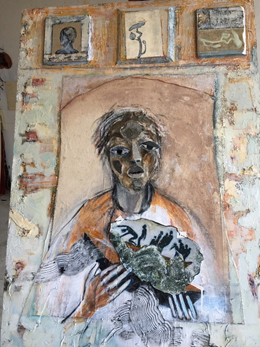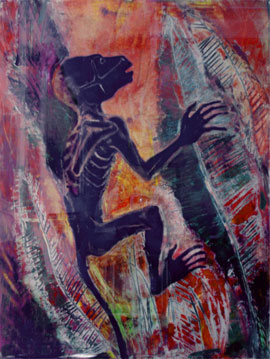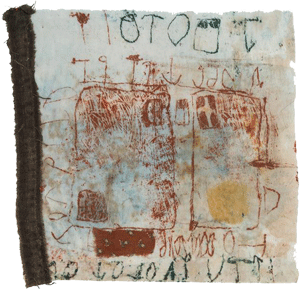A Woman at Her Window
John Haberin New York City
Mary Frank in 2020 and Hannelore Baron
For her winter show in Chelsea, Mary Frank had two bodies of work. Paintings might well have belonged to a single ambitious narrative, while smaller works on stone, together on a shelf, might have been literal fragments themselves.
In her latest, the two bodies come still closer together, in painting and assemblage. They could almost have a single person at their core, with an urgency all her own. You knew her well, the woman at a window. You may have just chosen to forget. As a postscript, Hannelore Baron made the collage works on view in Chelsea in the early to mid-1980s, in what was to be the last half decade of her creative life. It seems only right, for they look like the last hopes of someone unknown to leave a trace behind. 
Past and present
Not Juliet waiting for Romeo or the majas from Francisco de Goya in all their finery, waiting for you. Not that Frank's woman lacks for affection, not when it has brought tears to her eyes and made her cling to the silhouettes on stone cradled in her arms. She will cling to that stone shard however it breaks. Still, one is not likely to find her a young love or temptation, with her face literally made of stone—or between the sharp angles of her chin, her scraggly hair, her lips parted in pain, or the rude blotches in place of blushing or shadows in her cheeks. She is closer to another from Goya, a man looking for fleas in his shirt as an emblem of the filth of poverty and war. While Frank is hardly making simply political art, she describes her silhouettes, who stand in a small boat, as refugees today.
Then, too, where shadowy men lurk in the background of Goya's Majas on a Balcony, unknown others frame Frank's woman as well. Some have their own painted frame or thought balloons. They could recall everything that she has lost or refuses to lose. Some might be dancing or at play. Others could be vegetation with its promise of growth. Their ocher, like the stone grays, keeps them close to the earth.
A framed woman has a long history in art. Windows like hers often appear beside a formal portrait, to place the sitter in luxuriant imaginings or surroundings. Leonardo da Vinci adapts the motif several times to a Madonna and child—once in a panel with an arched top like a window or niche itself. Frank's boat could well take the place of the child. The silhouettes could also fit just fine into street art or cave painting, and another face could have leapt right off the walls at Pompeii. This art moves easily between past and present.
It does just by tallying up the losses. The silhouettes form a line, right to left, and the lead figure kneels as if to leap into the void, to death or to freedom. They recall the busy narrative of many a younger artist now. Now in her eighties, Frank has been there long before. That winter show paired her with an older American artist at that, Charles Burchfield, who made his New England landscape into a vision. They could almost have shared that vision, even as they shared a room.
The vision could be personal for Frank, too, who was once a refugee herself. Born in England, she moved to Brooklyn as a child during the Battle of Britain. She studied with other exiles in America, Max Beckmann and Hans Hofmann, who also taught Lee Krasner and a generation of postwar American art, but she found herself soon enough at home. She spends much of the year in upstate New York—looking often, of course, out the window. This is her New England, too. She first married Robert Frank, the photographer who crossed America, and she took up photography for ten years before her recent return to painting, but much later and altogether on her own terms, not his.
The pain is real, but an ordinary photographer's documentary impulse seems ever so far away. So for that matter does Burchfield's pure landscape. Frank is painting people, even when they merge with brute animals—but then Robert Frank did call his classic not America but The Americans. She may be best known for sculpture of people, too, most especially women. Their heads in unpainted clay appear as fragments without a pedestal, much like her stone. They look, if possible, even more vulnerable.
A blankness or a guise
Painting on stone is an interdisciplinary art, and she has studied music and dance as well. She is married now to Leo Treitler, a musician and scholar of music, and she has collaborated with an environmental scientist as well. Again the reality of raw earth colors the long view of art. Other images have the harsh colors of African masks. They are also artifacts, like stones, and indeed a fish could almost be an actual impress like a fossil.  Frank adds loose traces below her woman's long fingers, perhaps with a carpenter's comb, as if etched directly in stone.
Frank adds loose traces below her woman's long fingers, perhaps with a carpenter's comb, as if etched directly in stone.
Not that the figures look any less real. A mask implies a blankness or a guise, but the faces have personal variations from work to work. One could encounter many more faces in her winter show, close but never quite in communication. One might think that one knows them. Still, the more one sees them together, the clearer it is how little one can. One can never separate them from the myth or the mask.
Art, it goes without saying, finds a second or third life in the eyes of others and the hands of the artist themselves. (To be honest, Frank herself never imagined the woman's frame as a window, and she is, pointedly, Woman Looking at Us.) The woman at her window in fact returns Frank to a much earlier work that had left her unsatisfied. If her photos capture not the outside world but rather her paintings on the studio floor, the paintings in turn have their broader reach. As she asks in a new essay for her gallery, "What is art for?" She means neither the myths nor the masks as an escape.
Her most recent paintings, like that woman, only deepen their roots in this world. One sticks to black and white for eyes, lips, and cheek, while looking beyond personal identity. It presents a face as a mask. Figures leap again into the void across their rocky nose and forehead, whether to life or to death. In a cover illustration for the May 28 issue of The New York Review of Books, a woman leaps perilously between rocks—and never mind that they are equally isolated or only a body's length apart. But then from its shape the larger painting's arched window could instead be a headstone.
Still, Frank's art comes down not to the certainty of death, but to the uncertainties of life. Some faces speak directly to growth by incorporating leaves as well as stone. (You might mistake them for celery and reward yourself with a drink.) In one, the diver on its nose is gone, while the figure on its forehead spreads its wings in flight. Bright color enters again, with a red cheek playing against the yellow-green of its leafy nose. The face looks all the more mask-like for that, but also more down to earth.
The ambiguity of observation and vision brings her art closer still to the present. When she returns to an image after some years, it is because some aspect still speaks to her. Her entire working method of recycling motifs and materials offers the repeated chance to revisit her visions. In the hands of so experienced an artist, they become lives on a par with hers. The mask has let slip. Just dare yourself to remember that you may know them, too.
Without a trace
Hannelore Baron knew well what it is like to vanish without a trace. She died of cancer at age sixty, in 1987, but she had been escaping death for much of her life. She was only a child in 1939, when she and her family escaped the Nazis by slipping across the border from Germany into France and, from there, to momentary safety in Luxemburg. She was barely a teen when, two years later, they gained entry to the United States. Others were not so lucky. One can think of her as remembering them as well. 
These are beautiful but desperate traces. Dense scrawls have the immediacy of marks from someone who cannot stop until one can no longer ignore them. She has touches of green and other colors, but she favors black and red ink. She might be falling back on her own blood, denied anything more. One can make out a flower, like a final clinging to life. One can spot a pitch black hand, from its physical imprint on paper, or a blackened face, but whose?
Letters and numbers here and there (or something close to them) are no easier to decipher. Art can serve as a record, and the collaged paper and fabric may look like official documents—whether the visa that brought Baron to the Bronx or files from an extermination camp. For all their immediacy, there is no escaping that they belong to the past. She liked used fabric, she wrote, because it already showed its age. A show of just twenty works is relegated to a back room, interrupted by paintings on the floor and furniture, while the main gallery held portraits by Benny Andrews. And that, too, seems only right, as a record of lives that others wished to forget.
There is always the "virtual exhibition" online, but being there with the work brings out the difficulty of deciphering her art and the felt compulsion to try. It never quite hews to a grid, like damaged or unfinished records, but it comes just close enough to keep the scrawls from descending to doodles. Baron also constructed small boxes or books covered with much the same designs, starting in the late 1960s. One might think of boxes from another collector of forgotten worlds, Joseph Cornell, or of book art, but boxes and books can hold records, too. If the scrawls resemble later street art, these are private records, in containers that no one can open.
They may not be easy reading, but she meant them as political art. The gallery quotes her as comparing them to marches, self-immolation, and assassinations. Note here the range of references—from America in the present to protests by Buddhist monks to anarchists many years before. She wanted art to stand for truth, but also to stand for everything. She summed up her subject as "the human condition," which can sound pretentious or empty. Still, it was thoroughly relevant to a woman who came of age when Existentialism was a big deal, and art's claim to the universal was felt as real.
For all that, it is hard not to come to her work looking for her, even apart from her childhood. The lines on paper could equally belong to a calendar or journal. If she salvaged fabric, she went to high school in a textile school in Manhattan. If she made her own books, she married a book collector. She got a slow start as an artist, with her first collage work in her thirties, but she stuck ever after with the elements she had found—and to their fragile bridge between public and private lives. Other images include ladders and windows, and she had found both a view beyond herself and the means of escape.

A related review looks at Mary Frank at D. C. Moore in winter 2020. Frank was kind enough to share some recent images via email and to speak with me about them by phone. Of course, unduly sentimental associations and outright mistakes are mine. Hannelore Baron ran at Michael Rosenfeld through February 27, 2021.




